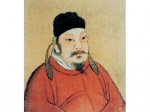General Huo-Qubing
 Huo Qubing was a famous general during the reign of Emperor Wu of the Western Han Dynasty. He was the nephew of another famous general Wei Qing.
Huo Qubing was a famous general during the reign of Emperor Wu of the Western Han Dynasty. He was the nephew of another famous general Wei Qing.
Despite his humble birth, Huo Qubing was very diligent and eager to learn. He had a good command of all kinds of martial skills like horsemanship, archery and swordsmanship etc. He had extraordinary looks, strong characters and remarkable wisdom and courage. Emperor Wu of the Han Dynasty appreciated his talent and appointed him as a guarding official responsible for the emperor’s safety.
At that time, wars frequently broke out between the Western Han Dynasty and the Hun ethnic group. Huo Qubing’s uncle Wei Qing made great battle achievements by leading troops to fight the Hun for several times. In the spring of 123 BC, Emperor Wu of Han organized an anti-attack battle against the Hun once again. Huo Qubing offered to fight in the battle and was appointed top-ranking military general. In the battle, Huo Qubing led a cavalry of 800 men to attack the enemy after a long march and defeated the Hun by a surprise. Emperor Wu of Han was in high praise of him for the brilliant achievement.
Huo Qubing was well versed in the art of war and would adopt flexible strategies. He never rigidly adhered to traditional tactics. Meanwhile, he himself was a fearless fighter. With an unconquerable spirit, he was always in the van of his men in battles. He was so invincible that was dubbed “unbeatable divine fighter“. In the ensuing major battles, Huo Qubing recovered the plain in the west of the Yellow River, officially bringing the corridor west of the Yellow River into the land of the Han Dynasty. Together with Wei Qing, he destroyed the main forces of the Hun, keeping the military threat to the Western Han Dynasty at bay. Thus, he gained brilliant military success.
In 117 BC, Huo Qubing died of illness at the early age of 24. Emperor Wu of Han especially ordered the construction of a Qilian Mountain-shaped tomb for Huo Qubing beside his own mausoleum. In front of the tomb, there was a stone statue of “The Huns under the Hoofs of Horses“, signifying the immortal feats Huo Qubing made for the country. Today, the tomb is kept intact.
Han especially ordered the construction of a Qilian Mountain-shaped tomb for Huo Qubing beside his own mausoleum. In front of the tomb, there was a stone statue of “The Huns under the Hoofs of Horses“, signifying the immortal feats Huo Qubing made for the country. Today, the tomb is kept intact.



You must be logged in to post a comment.